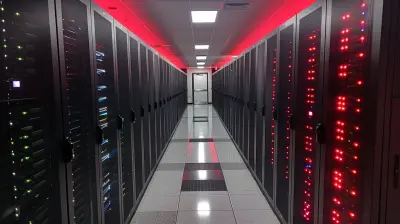The Rise of Software-Defined Networking (SDN)
26 February 2025
In the ever-evolving world of technology, we're constantly hearing about new advancements that promise to revolutionize the way we live and work. One of the most significant of these breakthroughs in recent years is Software-Defined Networking, or SDN for short. Whether you're a tech enthusiast or just someone trying to keep up with all the jargon being tossed around, SDN is something you should definitely have on your radar. But what exactly is SDN, and why is it becoming such a big deal?
Let’s dive into the world of SDN and break down what it is, how it works, and why it's gaining traction in the networking world. By the end of this read, you’ll have a solid grasp of SDN and why it's shaping the future of networking.

What Is Software-Defined Networking?
Alright, so let’s start with the basics. In traditional networking, hardware plays a huge role. Devices like routers, switches, and firewalls all work together to direct traffic and keep the network running smoothly. These devices are typically managed individually, which can get pretty complicated and cumbersome as networks grow larger and more intricate.This is where SDN comes in as a game-changer. SDN is a network architecture approach that separates the control plane (the brain of the network) from the data plane (the muscle that moves data around). In simpler terms, it’s like giving your network a centralized brain that can make decisions, while the individual hardware components just focus on moving the data.
The Key Components of SDN
To understand SDN better, let’s break down its key components:- Control Plane: This is the "brain" of the network. It decides how data should be handled and where it should be sent. In SDN, the control plane is centralized, meaning all the decision-making happens in one place.
- Data Plane: Also known as the "forwarding plane," this is where the actual data transfer happens. Think of it as the muscle of the system. It takes the instructions from the control plane and makes sure that data gets from point A to point B.
- SDN Controller: This is essentially the central hub of the SDN architecture. It communicates with both the control plane and the data plane, ensuring everything runs smoothly. The SDN controller is like the conductor of an orchestra, making sure every instrument (or in this case, every piece of hardware) plays its part in harmony.
- Northbound and Southbound APIs: These are the communication pathways between the different layers of the SDN architecture. Northbound APIs allow the SDN controller to communicate with higher-level applications, while Southbound APIs help it communicate with the data plane. Don’t stress too much about the technicalities—just think of them as the translators that help everything talk to each other.

Why Is SDN Gaining Popularity?
Now, you might be wondering, “Why are people so hyped about SDN?” There are several reasons why SDN is becoming increasingly popular, and it all boils down to flexibility, efficiency, and scalability.1. Flexibility and Control
One of the biggest perks of SDN is the flexibility it offers. In traditional networks, making changes or adding new devices often requires manual configuration of each device. It’s like trying to rewire your entire house every time you want to install a new light fixture—tedious, right?With SDN, network administrators can manage the entire network from a single point of control. This centralized control means they can make changes on the fly, deploy new services, and adjust traffic flows without having to physically touch the hardware. It’s like having a remote control for your entire network.
2. Cost Efficiency
Here’s the thing: Networking hardware is expensive. Traditional networks rely heavily on proprietary hardware, which can burn a hole in your pocket pretty quickly. SDN, on the other hand, allows organizations to use cheaper, off-the-shelf hardware because the “smarts” are in the software. This can lead to significant cost savings, especially for large enterprises that need to scale their infrastructure.In short, SDN helps cut down on hardware costs while improving the overall efficiency of the network. It’s like upgrading to a more fuel-efficient car—you’re still getting where you need to go, but you’re saving money along the way.
3. Scalability
As businesses grow, so do their networking needs. Traditional networks can struggle to keep up with this growth because they often require complex and time-consuming manual configurations. SDN, however, is built for scalability. Since the control plane is centralized, scaling up or down is as simple as tweaking the software, rather than physically adding or altering hardware.This scalability is particularly valuable for businesses operating in dynamic environments, like cloud computing or data centers, where resources need to be allocated and adjusted rapidly.
4. Improved Security
Security is a top concern in today’s digital age, and SDN can help provide an extra layer of protection. Since the control plane is centralized, network administrators have a bird’s-eye view of the entire network. This means they can detect and respond to threats more quickly.Additionally, SDN allows for the creation of virtual networks, which can be isolated from the rest of the network. This isolation helps contain potential security breaches before they can spread. It’s like putting up a firewall around a single room in your house to prevent a fire from spreading to the rest of the building.
5. Automation
Automation is a buzzword in tech these days, and for good reason. SDN enables automation by allowing network administrators to programmatically manage the network. This reduces the need for manual intervention and minimizes human error, which can be a huge headache in traditional networking.With SDN, network tasks like traffic management, load balancing, and security configurations can all be automated. Imagine being able to set your network on autopilot, freeing up time for more strategic tasks. Sounds pretty nice, right?

The Role of SDN in Modern Technologies
Now that we’ve covered the basics of SDN and why it’s so appealing, let’s take a look at some of the areas where SDN is making a real impact.1. Cloud Computing
Cloud computing has taken the world by storm, and SDN is playing a critical role in its success. In cloud environments, resources need to be allocated dynamically based on the changing needs of users. SDN’s centralized control and scalability make it the perfect fit for managing cloud infrastructure.With SDN, cloud providers can easily manage and optimize their networks, ensuring users get the performance they need without overprovisioning resources.
2. Data Centers
Data centers are the beating heart of the digital world, housing the servers and storage that power everything from social media to online shopping. As data centers grow larger and more complex, managing the network becomes increasingly challenging.SDN helps data center operators manage traffic more efficiently, optimize resource usage, and scale their infrastructure as needed. It’s like adding a traffic control tower to a busy airport—everything runs more smoothly when there’s someone directing the flow.
3. Internet of Things (IoT)
The Internet of Things (IoT) is exploding, with billions of devices connecting to networks around the globe. Managing all these devices can be a logistical nightmare, but SDN can help simplify the process. With SDN, IoT networks can be more easily configured and managed, allowing for better performance and security.Plus, SDN’s ability to create virtual networks means that different IoT devices can be isolated from one another, minimizing the risk of a security breach spreading across the entire network.
4. 5G Networks
As 5G networks continue to roll out, SDN is playing an important role in ensuring they deliver on their promises of faster speeds and lower latency. The flexibility of SDN allows telecom providers to dynamically manage network resources, ensuring users get the best possible performance.Additionally, SDN can help manage the increased complexity that comes with 5G networks, which are expected to support a massive number of devices and services.

Challenges of SDN
Before we wrap up, it’s important to note that while SDN has a lot of benefits, it’s not without its challenges.- Complexity: Implementing an SDN solution can be complex, especially for organizations that are used to traditional networking. The learning curve can be steep, and it requires a shift in mindset from hardware-based networking to software-based networking.
- Security Risks: While SDN can improve security, it also presents new risks. Centralizing control means that if the controller is compromised, the entire network could be at risk. Additionally, the APIs used in SDN can be vulnerable to attacks if not properly secured.
- Vendor Lock-In: Although SDN is supposed to promote openness and flexibility, some solutions are still tied to specific vendors, which can limit the potential for interoperability across different platforms.
Conclusion
Software-Defined Networking is truly a transformative technology in the world of networking. By decoupling the control and data planes, SDN offers unprecedented flexibility, scalability, and cost efficiencies. It’s no wonder that industries ranging from cloud computing to telecommunications are embracing SDN as a way to streamline their operations and stay ahead of the curve.However, like any new technology, SDN comes with its own set of challenges. Organizations looking to implement SDN need to weigh the benefits against the potential risks and challenges. But with the right approach, SDN can be a powerful tool for modernizing and optimizing network infrastructure.
If you haven’t already, it might be time to consider how SDN could benefit your business or organization. The future of networking is software-defined, and it’s happening now.
all images in this post were generated using AI tools
Category:
NetworkingAuthor:

Gabriel Sullivan
Discussion
rate this article
21 comments
Gunner Rivera
Exciting developments! SDN promises to transform networking, empowering innovation and enhancing connectivity for all.
March 25, 2025 at 10:01 PM

Gabriel Sullivan
Thank you! We're thrilled about the potential of SDN to reshape the networking landscape and drive innovation. Your enthusiasm is appreciated!
Flint Reed
The rise of Software-Defined Networking (SDN) marks a pivotal shift in network management. By decoupling the control plane from the data plane, SDN enhances flexibility and efficiency, enabling dynamic resource allocation. However, organizations must navigate security challenges and interoperability issues as they embrace this transformative technology.
March 21, 2025 at 7:59 PM

Gabriel Sullivan
Thank you for your insightful comment! You highlight key points about SDN's flexibility and the importance of addressing security and interoperability challenges as organizations adapt to this technology.
Sari McCaffrey
SDN is changing the game—exciting times ahead!
March 19, 2025 at 9:28 PM

Gabriel Sullivan
Thank you! We're thrilled about the potential of SDN to transform networking as we know it. Stay tuned for more innovations!
Reagan McGinn
Great article! It’s exciting to see how Software-Defined Networking is transforming the tech landscape. Looking forward to more insights on this innovative approach!
March 18, 2025 at 8:30 PM

Gabriel Sullivan
Thank you! I'm glad you enjoyed the article. Stay tuned for more insights on SDN!
Thalwen Warner
The rise of Software-Defined Networking (SDN) signifies a paradigm shift in network management, enhancing flexibility and scalability. By decoupling control and data planes, SDN empowers dynamic resource allocation and improved network performance.
March 16, 2025 at 5:09 AM

Gabriel Sullivan
Thank you for your insightful comment! Indeed, SDN's decoupling of control and data planes is transforming network management, enabling greater flexibility and efficiency.
Selene Watson
Embracing Software-Defined Networking is not just a trend; it's a revolutionary leap towards agility and innovation in networking. As we move into an era where flexibility and automation reign supreme, SDN empowers organizations to adapt swiftly, driving unparalleled efficiency and paving the way for the future!
March 15, 2025 at 12:29 PM

Gabriel Sullivan
Thank you for your insightful comment! Absolutely, SDN is transforming networking by enhancing flexibility and enabling rapid adaptation, which is crucial for innovation and efficiency in today's digital landscape.
Gabriella McQuillan
Software-Defined Networking is revolutionizing network management, offering unparalleled flexibility and efficiency. Embrace this transformative technology for future-ready infrastructures.
March 14, 2025 at 8:32 PM

Gabriel Sullivan
Thank you for your insightful comment! I completely agree—SDN is indeed transforming network management and is essential for building adaptable, future-ready infrastructures.
Clarissa Ramirez
This article effectively highlights the transformative impact of Software-Defined Networking (SDN) on network management and flexibility, while also acknowledging the challenges and limitations that organizations may encounter during implementation.
March 10, 2025 at 7:15 PM

Gabriel Sullivan
Thank you for the feedback! I'm glad you found the article balanced in highlighting both the benefits and challenges of SDN.
Harrison Rosales
Great insights on Software-Defined Networking! The flexibility and scalability SDN offers can truly transform network management. As organizations increasingly rely on cloud services and IoT, embracing SDN will be crucial for optimizing performance and security. Excited to see how this technology evolves further!
March 9, 2025 at 12:15 PM

Gabriel Sullivan
Thank you! I appreciate your insights and enthusiasm for the future of SDN. It's an exciting time for network innovation!
Lanae Riley
In the realm where data streams flow, Software-defined networks begin to grow. Flexibility reigns, a dance of the code, Empowering connections, lightening the load. A symphony of bytes in orchestrated grace, SDN shapes the future, a digital embrace.
March 8, 2025 at 8:39 PM

Gabriel Sullivan
Thank you for the poetic encapsulation! Your lines beautifully capture the essence and transformative power of SDN in the digital landscape.
Nyari Edwards
Software-Defined Networking revolutionizes network management, enhancing flexibility and efficiency while reducing operational costs and complexity.
March 8, 2025 at 12:10 PM

Gabriel Sullivan
Thank you for your comment! Indeed, SDN transforms network management by offering increased flexibility and efficiency, ultimately driving down costs and simplifying operations.
Lilith Anderson
Great article on SDN! The shift towards software-defined networking is revolutionizing network management by enhancing flexibility and scalability. As organizations increasingly adopt SDN, it will be exciting to see its impact on industry standards and overall network performance.
March 8, 2025 at 3:38 AM

Gabriel Sullivan
Thank you! I'm glad you enjoyed the article. The impact of SDN on network management is indeed transformative!
Andrea Romero
Embracing Software-Defined Networking is a transformative leap into the future of connectivity! As technology reshapes our world, SDN empowers innovation, enhances efficiency, and creates limitless possibilities. Let’s harness this revolution to build smarter networks and foster a dynamic digital landscape together!
March 5, 2025 at 7:26 PM

Gabriel Sullivan
Thank you for your enthusiastic comment! Indeed, SDN is revolutionizing connectivity and paving the way for a smarter, more efficient digital landscape. Let’s continue to embrace this innovation together!
Avianna Sawyer
Embracing Software-Defined Networking opens doors to innovation and flexibility in IT. As we navigate this exciting evolution, let's harness the power of SDN to create more efficient, scalable networks that empower businesses to thrive in a digital-first world!
March 5, 2025 at 1:27 PM

Gabriel Sullivan
Thank you for your insightful comment! Embracing SDN indeed paves the way for innovative and agile networking solutions, essential for thriving in today’s digital landscape.
Elowen McLemore
As networks evolve, SDN emerges as a silent architect, reshaping our digital landscape. What hidden potential lies within this technology? The future of connectivity may hold secrets yet to be uncovered.
March 2, 2025 at 3:19 AM

Gabriel Sullivan
Thank you for your thoughtful comment! Indeed, SDN's flexibility and programmability unlock vast potential for innovation in network management and optimization, paving the way for a more responsive and efficient digital future.
Merida McGee
While SDN promises greater network flexibility and efficiency, its rapid adoption raises concerns about security vulnerabilities and vendor lock-in. A balanced approach, prioritizing robust security measures alongside innovation, will be crucial for sustainable growth in this space.
March 1, 2025 at 4:22 AM

Gabriel Sullivan
Thank you for your insights! Balancing innovation with security is indeed essential for the sustainable growth of SDN. Your concerns about vulnerabilities and vendor lock-in are valid and warrant careful consideration as the technology evolves.
Selena Holland
The rise of Software-Defined Networking (SDN) represents a paradigm shift in our approach to network management, inviting us to rethink the axes of control and flexibility. As traditional boundaries blur, we must consider the implications for security, scalability, and the ethics of automated decision-making in an increasingly connected world.
February 28, 2025 at 1:39 PM

Gabriel Sullivan
Thank you for your insightful comment! You're absolutely right—the shift to SDN challenges us to reassess not only our management strategies but also important considerations around security and ethics in this evolving landscape.
Zora Butler
SDN: finally a network that listens better than my last boyfriend. Cheers to progress!
February 27, 2025 at 7:59 PM

Gabriel Sullivan
Cheers to that! SDN truly transforms networking, making it more responsive and adaptable. Glad you see the progress!
Logan Nelson
Software-Defined Networking revolutionizes network management, offering flexibility and scalability while reducing operational complexity, ultimately paving the way for more dynamic infrastructures.
February 27, 2025 at 11:15 AM

Gabriel Sullivan
Absolutely! SDN transforms network management by enhancing flexibility and scalability, simplifying operations, and enabling dynamic infrastructures. Thank you for highlighting its impact!
Dahlia McGill
Software-Defined Networking (SDN) revolutionizes network management by decoupling the control plane from the data plane, enabling centralized control and automated provisioning. This enhances flexibility, scalability, and efficiency, addressing modern demands for dynamic network environments in cloud computing and data centers.
February 26, 2025 at 9:46 PM

Gabriel Sullivan
Thank you for your insightful comment! You’ve captured the essence of SDN's impact on network management perfectly.
Silas Castillo
What an exciting time for technology! The rise of Software-Defined Networking (SDN) is transforming how we manage networks, making them more agile and efficient. Can't wait to see how SDN will revolutionize our digital experiences and enable even more innovative solutions! 🚀✨
February 26, 2025 at 3:25 AM

Gabriel Sullivan
Absolutely! SDN is indeed a game-changer, paving the way for unprecedented agility and innovation in network management. Exciting times ahead! 🚀
MORE POSTS

How to Set Up a VPN on Your Router for Enhanced Security

Data Sovereignty and Data Centers: Navigating International Regulations

The Compact Revolution: Portable Tech Shrinking in Size, Growing in Power

Exploring the Role of Tech in Revolutionizing Education

The Ultimate Smartwatch Buying Guide for Fitness Enthusiasts

Understanding the Role of 5G in IoT Device Connectivity

Augmented Reality Glasses for Real Estate: A New Perspective

How IoT is Bridging the Gap Between Physical and Digital Worlds

Tech Conferences That Are Defining the Future of Work

Oculus Quest vs. PlayStation VR: Best VR Headset for Gamers
Fitbit vs. Samsung Galaxy Watch: Best Wearable for Fitness Tracking

Understanding Shared Responsibility in Cloud Security

Understanding Network Security Protocols: WPA3 and Beyond